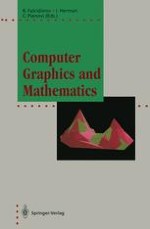1992 | OriginalPaper | Buchkapitel
Visualizing Hyperbolic Space
verfasst von : Charlie Gunn
Erschienen in: Computer Graphics and Mathematics
Verlag: Springer Berlin Heidelberg
Enthalten in: Professional Book Archive
Aktivieren Sie unsere intelligente Suche, um passende Fachinhalte oder Patente zu finden.
Wählen Sie Textabschnitte aus um mit Künstlicher Intelligenz passenden Patente zu finden. powered by
Markieren Sie Textabschnitte, um KI-gestützt weitere passende Inhalte zu finden. powered by
Computer graphics opens windows onto previously unseen mathematical worlds. This has been firmly established in the study of chaotic dynamical systems, where significant mathematical discoveries can be directly traced to the advent of visual display of computation. Other realms of science and mathematics stand to derive particular benefit from the powers of computer graphics. For example, non-Euclidean geometry is fundamental to many research areas in mathematics and physics. Heretofore, this has not been amenable to visualization, because standard visualization environments are implicitly Euclidean, or flat. Some of the simplest examples of these curved spaces are non-Euclidean geometries of constant curvature. This paper will describe work in visualizing such geometries, undertaken at the Geometry Supercomputer Project as part of a program to explore 3-dimensional manifolds. In particular, we demonstrate techniques for realistic rendering in three-dimensional hyperbolic space using readily available software tools. We have demonstrated the usefulness of these tools by making a computer graphics movie “Not Knot” which contains several minutes of animation inside hyperbolic space.The discussion will be structured as follows: Previous workMathematical models of hyperbolic geometry.Comparison of utility of different models of hyperbolic geometry.Rendering in hyperbolic space using custom Renderman 1 shaders.Three dimensional topology and hyperbolic geometry.A case study: the Borromean rings and the video “Not Knot”Conclusion and new directions.Appendix 1: Copy of Renderman shader for hyperbolic plastic surface.
